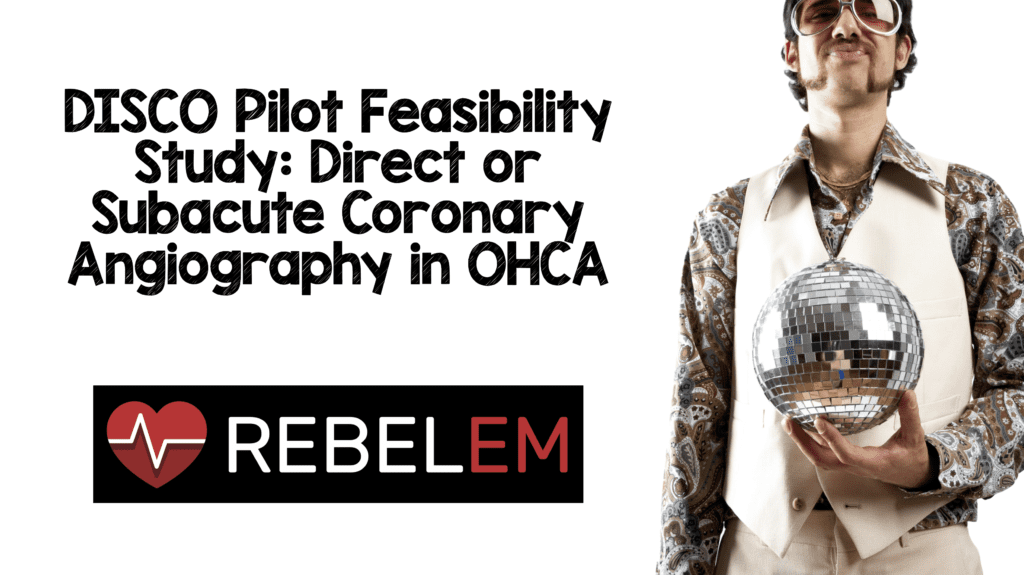
 Background: The clinical importance of immediate coronary angiography, with subsequent percutaneous coronary intervention (PCI) in OHCA patients without STEMI is a matter of debate. We have already covered the COACT trial on REBEL EM, but this is a second study, the pilot phase of the DISCO trial, assessing immediate vs delayed coronary angiography in patients with OHCA and without STEMI on ECG.
Background: The clinical importance of immediate coronary angiography, with subsequent percutaneous coronary intervention (PCI) in OHCA patients without STEMI is a matter of debate. We have already covered the COACT trial on REBEL EM, but this is a second study, the pilot phase of the DISCO trial, assessing immediate vs delayed coronary angiography in patients with OHCA and without STEMI on ECG.
What They Did:
- Pre-specified analysis of the pilot phase of the ongoing large randomized clinical trial of adult patients with bystander witnessed OHCA without STEMI on ECG.Randomized to:
- Immediate coronary angiography
- Standard care: Coronary angiography should not be performed earlier than 3 days after the cardiac arrest unless HD unstable (cardiogenic shock), sustained ventricular arrhythmias (VT/VF), or ECG changes (ST-elevation) indicative of cardiac ischemia
Outcomes:
- Feasibility:
- Prehospital and in-hospital time frames
- Randomization and informed consent issues
- Cross over (Adherence to protocol)
- Presenting ECGs
- Safety Aspects:
- Major and Minor Bleeding
- Renal Failure and Need for RRT
- Coronary Angiography and PCI Findings
- Secondary Transportations
- 24hr Mortality
Inclusion:
- Resuscitated bystander witnessed OHCA patients >18years of age without STEMI or presumed new LBBB on ECG
Exclusion:
- Obvious non-cardiac cause of OHCA
- Terminally ill patients with life expectancy <1year
- Expected time to coronary angiography more than 120 minutes
- Pregnancy
- Patients not unconscious (GCS >8)
Results:
- 79 patients randomized
- 39 patients in immediate angiography
- 40 patients in standard of care
- Additional 39 patients were enrolled in the observational STEMI non-randomized group
- Median time from EMS arrival to coronary angiography was 135 minutes in immediate angiography group
- No differences in proportion of major bleeding and renal failure
- Mortality at 24hrs:
- Immediate Angiography: 3/39 (7.7%)
- Standard Care: 6/40 (15%)
- Culprit lesion found in 14/38 (36.8%) of immediate angiography group and PCI performed in 15/38 (39.5%)
- 6/40 (15%) of patients randomized to standard of care, had coronary angiography performed before the stipulated 3 days
Strengths:
- Authors report observations from patients with OHCA and STEMI for comparisons regarding procedure related side effects
- Adverse events related to coronary angiography and PCI were low in all groups
- The proportion of coronary culprit lesions in this study was about 37% and on par with previous studies
Limitations:
- Used a subjective definition of critical stenosis, which was assessed by the operator as a stenosis of >50% (In the COACT trial, all coronary lesions were defined as a stenosis severity of ≥70% and the presence of characteristics of plaque disruption including lesion irregularity, dissection, haziness or thrombus defined by coronary angiography.)
- One of the inclusion criteria for immediate coronary angiography was the ability to perform the procedure within 120 minutes from EMS arrival at the scene of the arrest. Unfortunately, the majority of patients had a median time to coronary angiography of 135 minutes (Range 106 – 178min)
- Although there were no major adverse events in this study, it is important to realize that a small number of patients, might make it possible that important clinically safety issues could be missed
- Only 12% of OHCA arrest patients were randomized. The main reasons patients were not randomized were an obvious non-cardiac cause and unwitnessed cardiac arrest
- There is a risk of selection bias if clinicians tend to only randomize patients with low risk of having an occluded coronary artery
Discussion:
- The main DISCO trial is planned to recruit >1000 patients, but for this feasibility and safety study, only 80 randomized patients were required
- VF was the primary ECG rhythm in 52.6% of the immediate angiography group and 55% in the standard of care group
- An important question not answered by this study is whether OHCA patients should be transported directly to hospitals with 24/7 coronary angiography capabilities?
- Bystander CPR was performed in 73.7% of immediate angiography cohort, 75.0% of standard of care cohort, and 69.2% of observational STEMI cohort
- Requirement of norepinephrine during any ICU day was lower in the immediate angiography group 76.3% compared to the standard of care group 87.5%, but should be considered a surrogate measure and not a patient-oriented outcome
- Time to EMS Arrival, ROSC, and Coronary Angiography:

Author Conclusion: “In this out-of-hospital cardiac arrest population without ST-elevation, randomization to a strategy to perform immediate coronary angiography was feasible although the time window of 120 minutes from EMS arrival at the scene of the arrest to start of coronary angiography was not achieved. No significant safety issues were reported.”
Clinical Take Home Point: In this pre-specified analysis of the DISCO trial it is difficult to making any definitive conclusions as the number of patients and events were so low. We will just have to wait for the full 1000 patient cohort before weighing in on this study.
References:
- Elfwen L et al. Direct or Subacute Coronary Angiography in Out-of-Hospital Cardiac Arrest (DISCO) – An Initial Pilot-Study of a Randomized clinical Trial. Resuscitation 2019. [Epub Ahead of Print]
Post Peer Reviewed By: Anand Swaminathan, MD (Twitter: @EMSwami)
The post DISCO Pilot Feasibility Study: Direct or Subacute Coronary Angiography in OHCA appeared first on REBEL EM - Emergency Medicine Blog.

